There are common backstroke mistakes swimmers make despite the simplicity of the swimming stroke. Such mistakes are more noticeable among beginners. Interestingly, the backstroke is the easiest to perform since swimmers can breathe easily while swimming.
Consistent practice is significant to becoming a good backstroker. However, due to the nature of the stroke, most swimmers get some aspects wrong ignorantly. While recreational swimmers may feel less worried, professionals are more conscious of their swimming time.
This article is for you if you are one of those upcoming swimmers that need to improve their backstroke and overall swimming time. Let’s dive right in.
Table of Contents
5 Common Backstroke Mistakes to Avoid as a Professional Swimmer
Suppose you can float on the water comfortably. In that case, it becomes easy to initiate and coordinate the progression of your kicks and pulls during backstroke. Besides the fear of crashing into the pool wall, you have fewer concerns about breathing.
Despite the simplicity of the backstroke, some swimmers still struggle to swim satisfactorily. You might be making the following mistakes if you are among such swimmers. The corrections to these mistakes have been discussed alongside.
Mistake 1: Using a Wrong-Hand Entry
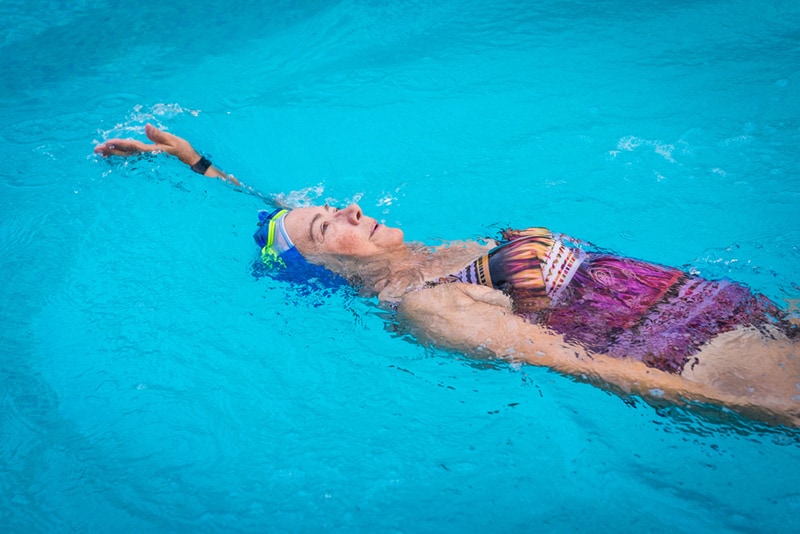
Many swimmers are guilty of these backstroke mistakes. In such instances, the swimmer enters the water with their backhand. Apart from reducing your swimming speed significantly, you also risk straining your wrist and hand while trying this entry.
To avoid this mistake, your pinky finger should be your primary entry point. Ensure your palm is turned outward to achieve a strong pull. Your arm will be angled to create pivot your hand towards the outside as you make an entry.
You should exit the water with your thumb facing up if appropriately executed. Also, when your hand emerges from the water, that hand will be somewhere around your hips. In other words, pinky in, thumb out.
Furthermore, when your hand is in the water, hold those fingers together all through the motion to generate a massive pull force. Let your hand move steadily through the water.
Mistake 2: Improper Head Positioning
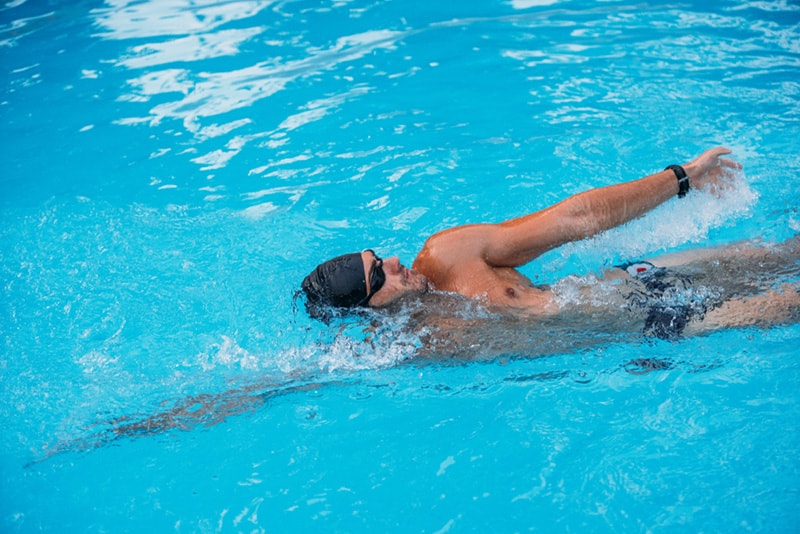
Another common mistake while swimming the backstroke is poor head positioning. This mistake can drastically keep you from reaching your potential swimming speed. For a beginner, it may not seem easy to discover by yourself.
Poor head positioning can constitute high swimming resistance. Here, some swimmers will tuck their chin into their chest such that they can see their toes. In other scenarios, the swimmer may want to look forward in the swimming direction.
Consequently, their spine (or body) bends significantly, affecting your buoyancy and making you less streamlined. An unnatural head position can cause discomfort to your neck. Furthermore, it is distracting to watch your toes while swimming.
Some swimmers raise their head far above the water in unusual situations. However, correcting this mistake isn’t tricky, but it takes some getting-used-to.
While performing the backstroke, align your head straight with your body and ensure to keep your neck relaxed. Float naturally on the water. Of course, your chin will face the sky or ceiling of an indoor swimming pool.
Mistake 3: Poor Body Positioning
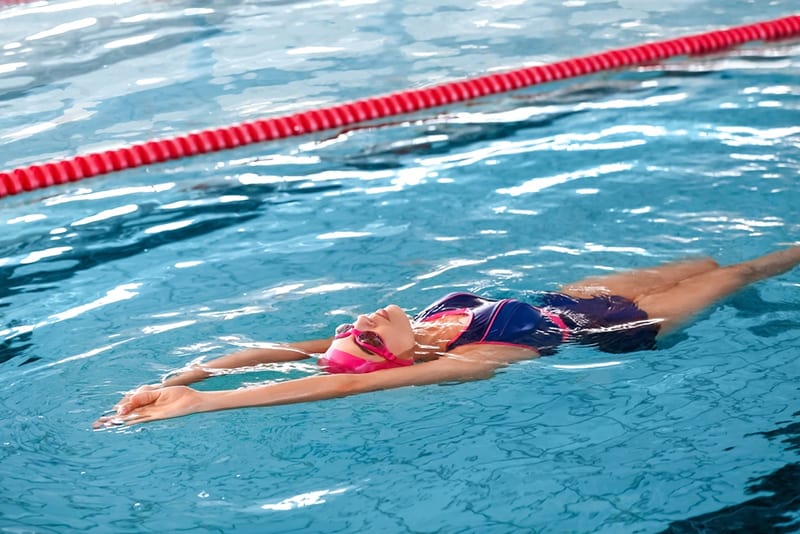
Alongside the head positioning, your body positioning can also be a mistake while backstroking. Also, you will struggle to balance and move fast while swimming. Some swimmers keep their torso (body) too flat in the water while swimming.
Consequently, you will be straining your arms harder to gain a strong pull due to the poor angle position. Therefore, the result is energy exhaustion and the possibility of shoulder and spine injuries.
It is also easy to fix this common backstroke mistake. When your right arm is in the position to pull through the water, your body should lie entirely on your right side till that arm breaks the water.
Conversely, when your left arm has reached the position to pull through, your body should lie entirely on the left side. Simultaneously, rotate your waist (hips) to avoid straining your arms. Position your body at a proper angle to improve your overall pulling strength.
Mistake 4: Bending Your Knees
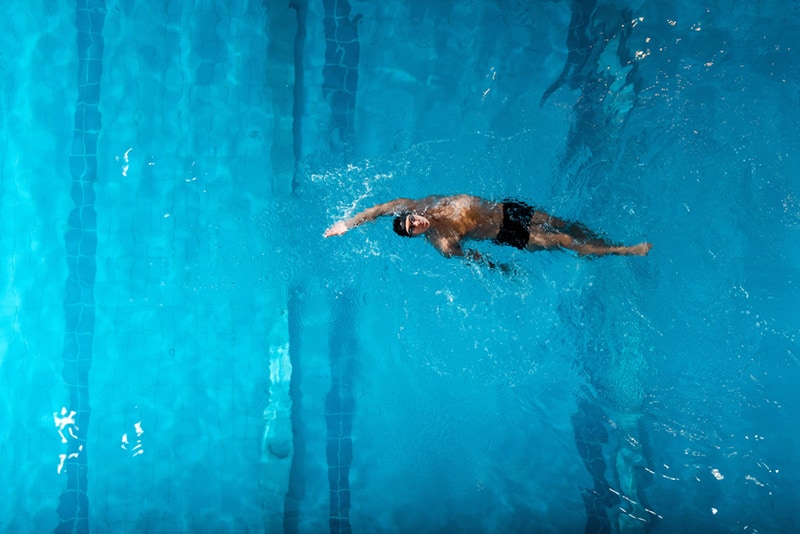
While swimming, some individuals get it all wrong with their knees. This backstroke mistake is noticeable when their knee shows at the water’s surface.
You want to keep your body as streamlined in the water as possible. Still, this mistake can impact your kicking efficiency. Furthermore, you will experience more drag, and your speed will be affected while swimming.
To correct this common mistake, you must keep your legs straight with little flex, as in the flutter kicks in freestyle swimming. Simultaneously, kick with force from your hips rather than the knees or lower legs.
You can work on correcting this mistake using a kickboard in a swimming pool. Push off the wall, place the board over your knees, and kick as you usually do. You can leave the swim fins for now.
If your knees continuously hit the board, you are likely bending them. Include this practice technique in your training session till you have tackled this mistake.
Mistake 5: Poor Kicking
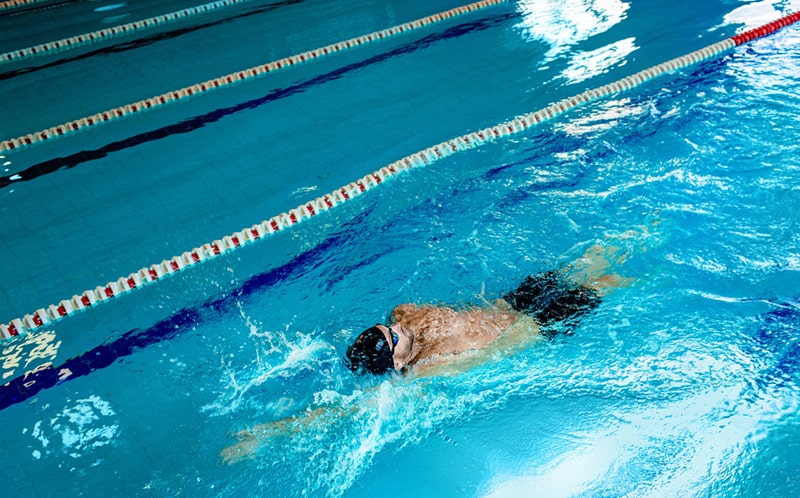
One of the most common mistakes in backstroke swimming is poor kicking. Many beginners have a wrong opinion about focusing on the arm for maximum swimming speed. Therefore, there is less kicking training.
Interestingly, top swimmers have mastered every aspect of backstroke swimming, including kicking. You can give your swimming speed a heavy boost by utilizing your kicking. A good percentage of your propulsion and stability can come from there.
To become a good backstroker, work on your kicking. Your backstroke kick should feel like it starts from the highest point of your hip bone, with force flowing smoothly down to your sharp toe.
The leg should be flexible but not too much so that your knee breaks the water. Always kick from your hips with adequate force. Your kicks should not be too close or far apart; a 20 to 30 inches difference is enough.
When you are kicking appropriately, working on your speed in backstroke will become even less stressful. You will also be able to kick longer.
Conclusion
Mastering every stroke is self-fulfilling and essential to becoming an elite swimmer. If you can address these five common backstroke mistakes, you will have removed every hindrance to becoming a top swimmer.
Although it requires some practice, correcting these mistakes is straightforward, even without a coach. You will be able to notice an improvement when you see some changes in your swimming time.
If you have questions or comments, I would appreciate it if you send them to me using the comment section. Additionally, sharing this article can help people learn about common backstroke mistakes. Kindly click any of the social media buttons on the page.

Leave a Reply